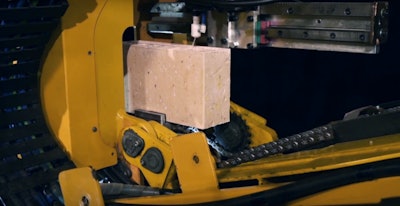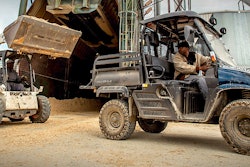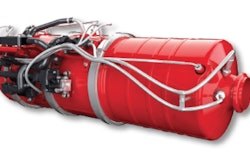 Fastbrick’s robotic bricklayer works like a 3D printer, building homes in just 1-3 days. Photos: Fastbrick
Fastbrick’s robotic bricklayer works like a 3D printer, building homes in just 1-3 days. Photos: FastbrickFastbrick Robotics, an Australian company developing a robotic bricklayer, has signed a Memorandum of Understanding with Caterpillar, a deal that will further develop Fastbrick’s technology, which is capable of 3D printing homes and other structures.
Cat says the new partnership will see the two companies working together in the development of robotic bricklaying technology including the manufacturing, sales and services surrounding the technology. To guide development, the companies have also agreed to establish a strategic alliance board comprised of representatives from both companies.
Caterpillar has also invested $2 million in Fastbrick through a placement. As part of the placement agreement, Fastbrick has agreed to issue fully paid ordinary shares in the company to Caterpillar at 10 cents AUD per share. Cat also has the option of investing an additional $8 million into Fasbrick at an issue price of 20 cents AUD per share. Fastbrick has announced it intends to seek shareholder approval of that investment within 60 days.
The deal gets Caterpillar in on the ground floor of a construction technology that has been creating a quiet, but sustained buzz. Videos of prototypes have been floating around the internet for the last few years, creating speculation around the future of human bricklayers. However, the market for these machines has yet to be realized as the technology behind them is quite complex.
Fastbrick is still working to bring its robot to market. It has a working prototype called the Hadrian X and the company plans to first release a finalized version of this bot in its home market of Australia. As you can see in the time-lapse video below, the robot can be attached to an excavator and sends bricks down a conveyor belt to the bricklaying mechanism. At the end of the line, mortar is spread along the brick before it is flipped, gripped and placed.
 The Fastbrick Hadrian X robotic bricklayer applies a line of mortar to a brick before placing it.
The Fastbrick Hadrian X robotic bricklayer applies a line of mortar to a brick before placing it.In terms of what type of bricks the machine can lay, Fastbrick says on its website the system has been designed to handle “a universal range of products up to 500mm x 250mm x 250mm in size.” (19.6 in. x 9.8 in. x 9.8 in.) The Hadrian X can lay 1,000 standard-size house bricks per hour.
We asked Caterpillar for more details on the nature of the Fastbrick development deal and whether the deal might place Fastbrick robots in Cat dealerships, but the company declined to comment.
Though much of the language around Caterpillar’s announcement of its deal with Fastbrick today deals with the bricklaying robot itself, what makes Fastbrick’s solution possible and, quite frankly, marketable, is that the company has developed a software platform that allows the robot to build structures in a similar fashion as a 3D printer would work.
The software, dubbed TAD, generates a 3D model of a home and sends that data along to the bricklayer bot. The robot then follows the generated plans and “prints the structure course by course just like a 3D printer, including all cutting and routing of the bricks for electrical and plumbing services so the finished structure is ready for first fixing within days,” according to a page on the Fastbrick website. The company says its robot is capable, depending on the complexity of the home design, of building a house in a range of 1-3 days.
As far as doors and windows go, Fastbrick says the “frames are lowered in from the top once the height has been reached, or fitted as split frames after the build process is complete. The Hadrian X or the onsite telehandler will place the lintels into position.”
Though the company states that the Hadrian X means that “no human hands need to touch a brick during the loading, cutting and laying process,” the company says that current bricklayers will be able to transition from their current work to bricklaying machine operation and site quality supervisors. “Fastbrick will endeavor to employ qualified bricklayers for site operations and we have built a network of current Bricklayers that will transition over to this method as the machines enter service,” the company says on its website.
Copy












